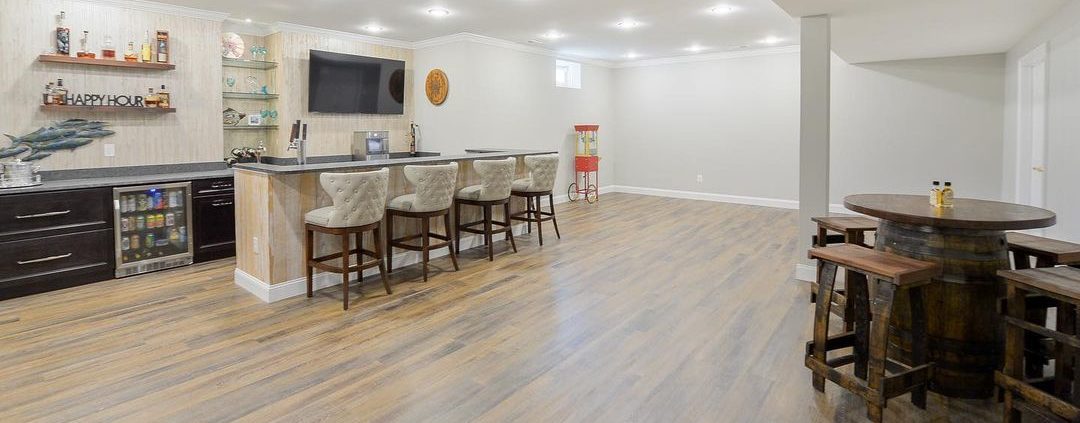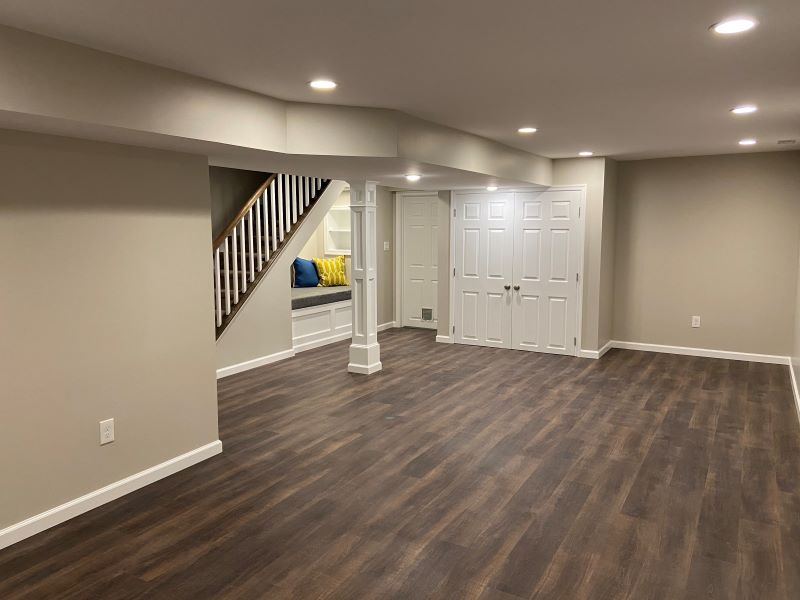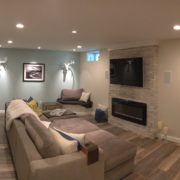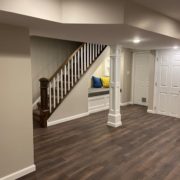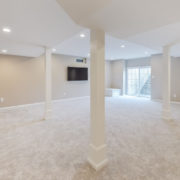Turning On to Finished Basement Lighting Ideas
At roughly one-third to half the cost of a comparably sized aboveground addition, finished basements are one of the best ways to add functional space to your home. However, there are a few important caveats that come with being partially or fully underground. One is that they are more susceptible to moisture. Another is that they may receive little to no natural light.
Of course, functional space isn’t really functional if you can’t see well enough to function. That’s why when we finish a basement, we should always have a plan to smartly and attractively incorporate lighting. In this month’s blog, we will share finished basement lighting ideas that will be sure to add both substance and style to your understory.
Basement lighting basics
It should come as no surprise that the first consideration of any basement lighting layout is the law, which is dictated by local building codes. Requirements vary depending on whether a space is deemed “non-habitable” or “habitable.”
New Jersey building code decrees that:
- Non-habitable rooms (e.g. staircases, hallways, cellars, basements, landings, furnace/utility rooms) must have “natural or artificial light available at all times, with illumination levels of at least 2 lumens per square foot in the darkest portions.
- Habitable rooms “have at least one window or skylight facing directly to the outdoors,” spanning at least 8 percent of the floor area of that room.
It may surprise you that finishing a basement does not necessarily make it habitable by the legal definition — it must be maintained with a set temperature range via connection to a home’s HVAC system. In other words, even if it looks pretty, it can’t be too cold.
If a basement room is habitable, code requires at least one lighting outlet and a corresponding wall switch, located near the room’s entrance (if it’s not a kitchen or bathroom, a floor lamp can serve instead of overhead or wall-mounted lights). Connecting halls or stairs must have their own lighting outlet and switch.
Basement lighting layouts
As we discussed in a previous blog about kitchen lighting layouts, there are three levels of lighting to consider when conceptualizing a space:
- Ambient lighting: Intended to illuminate an entire space.
- Task lighting: Focused lighting for specific tasks or activities.
- Accent lighting: Meant to accent or highlight a certain feature of the room, usually for decorative purposes.
Basement lighting types
Recessed/can lights
Recessed lights, also known as can lights, are by far the most widely utilized in modern finished basements. These cylindrical units (i.e. can-shaped) nestle into the ceiling (i.e. they are recessed), only revealing their trim. Pairing recessed lighting with dimmer switches allows fine control of luminosity and mood, and clustering them into zones can help define functional areas.
Ceiling lights
More traditional ceiling lights, which come in flush-mount and semi-flush mount varieties, are located in the center of the room and serve as ambient lighting. They check the box for meeting code requirements and can be aesthetically pleasing as well.
However, semi-flush mount lights may not play very well in basements with lower ceilings, as the fixture itself hangs below where the unit is mounted, increasing the risk of (literal) head-on collisions.
Sconce lights
Sconce lights attach directly to the wall and can be focused upward (for ambient lighting) or downward (for task lighting, such as reading). Sconce lights might be controlled through the wall switch or by a switch on the unit itself.
Floor lamps
Floor lamps offer versatility through portability — simply pick them up and move it to wherever it’s needed. You can plug them into a wall-controlled outlet and switch them on or off as you enter or leave a room, or you can place them next to a couch or seating area and use the switch on the lamp. They would function excellently in a den or game room.
Tray lights
As their name suggests, tray lights are housed within a tray that is installed along the perimeter of the ceiling. They are primarily used as accent lighting, as they do not generate much in the way of brightness (great if you’re reproducing a home theater, lounge, or nightclub vibe). A skilled interior carpenter will ensure they are integrated unobtrusively.
Track lights
Track lights are a popular form of task (e.g. above a basement bar) or accent lighting (e.g. above a painting, mantle, or trophy case). They consist of several units oriented along a solid metal or wire lighting track, which mounts to the ceiling. The major appeal here is the individual lighting heads can be swiveled or slid along the track without the enlistment of tools — you’re the director!
Like the semi-flush mount ceiling lights we mentioned earlier, they can cause clearance issues in basements with lower ceilings. This problem can be mitigated by locating the track closer to where a ceiling meets a wall, lessening the chances of anyone bumping into it.
Natural lighting
When we think of natural light and basements, we often think of the narrow hopper windows that hinge from the bottom and are just barely adequate for airing things out, much less capturing sunlight. As habitable spaces, we should expect more from our finished basements — in fact, in most states (including New Jersey), it’s the law that we have something more in the form of an egress (emergency exit) door or window.
Code requires that the following finished basement rooms have a point of egress:
- Bedrooms
- Rec rooms
- Offices
- Home theaters
In the event any of these spaces adjoin, only one of them needs an egress door or window — but bedrooms always take precedence. Deeper, below-grade basements must have an egress window well dug, with ladder or stairs for escape.
Egress doors and windows must first and foremost be openings through which human beings can easily escape, so they’re necessarily larger and operate differently than your standard basement hopper windows. With that comes the benefits of better airflow and more natural light — you might even forget that your basement room is in the basement!
See our friends at Egress Solutions in South Jersey to learn of all of the attractive possibilities available in a modern basement egress system.
Finished basements with Ayars
At Ayars Complete Home Improvements, we approach basement lighting design ideas like we do everything else — purposefully and with the big picture firmly in mind. We believe a finished basement should look like it organically belongs with the rest of your house — because it is part of your house. To see how this philosophy plays out in practice, visit our finished basement portfolio page for some prime examples

